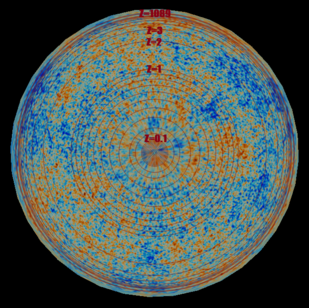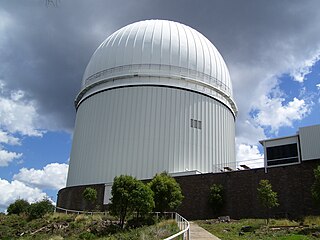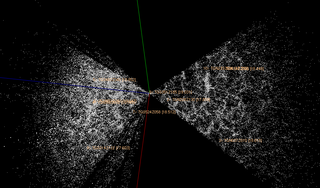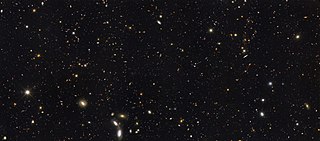
A quasar is an extremely luminous active galactic nucleus (AGN), in which a supermassive black hole with mass ranging from millions to billions of times the mass of the Sun is surrounded by a gaseous accretion disk. As gas in the disk falls towards the black hole, energy is released in the form of electromagnetic radiation, which can be observed across the electromagnetic spectrum. The power radiated by quasars is enormous; the most powerful quasars have luminosities thousands of times greater than a galaxy such as the Milky Way. Usually, quasars are categorized as a subclass of the more general category of AGN. The redshifts of quasars are of cosmological origin.

In physics, a redshift is an increase in the wavelength, and corresponding decrease in the frequency and photon energy, of electromagnetic radiation. The opposite change, a decrease in wavelength and simultaneous increase in frequency and energy, is known as a negative redshift, or blueshift. The terms derive from the colours red and blue which form the extremes of the visible light spectrum.

Hubble's law, also known as the Hubble–Lemaître law, is the observation in physical cosmology that galaxies are moving away from the Earth at speeds proportional to their distance. In other words, the farther they are the faster they are moving away from Earth. The velocity of the galaxies has been determined by their redshift, a shift of the light they emit toward the red end of the spectrum.

The Hubble Deep Field (HDF) is an image of a small region in the constellation Ursa Major, constructed from a series of observations by the Hubble Space Telescope. It covers an area about 2.6 arcminutes on a side, about one 24-millionth of the whole sky, which is equivalent in angular size to a tennis ball at a distance of 100 metres. The image was assembled from 342 separate exposures taken with the Space Telescope's Wide Field and Planetary Camera 2 over ten consecutive days between December 18 and 28, 1995.

Halton Christian "Chip" Arp was an American astronomer. He was known for his 1966 Atlas of Peculiar Galaxies, which catalogues many examples of interacting and merging galaxies, though Arp disputed the idea, claiming apparent associations were prime examples of ejections. Arp was also known as a critic of the Big Bang theory and for advocating a non-standard cosmology incorporating intrinsic redshift.

The Australian Astronomical Observatory (AAO), formerly the Anglo-Australian Observatory, was an optical and near-infrared astronomy observatory with its headquarters in North Ryde in suburban Sydney, Australia. Originally funded jointly by the United Kingdom and Australian governments, it was managed wholly by Australia's Department of Industry, Innovation, Science, Research and Tertiary Education. The AAO operated the 3.9-metre Anglo-Australian Telescope (AAT) and 1.2-metre UK Schmidt Telescope (UKST) at Siding Spring Observatory, located near the town of Coonabarabran, Australia.

Observational cosmology is the study of the structure, the evolution and the origin of the universe through observation, using instruments such as telescopes and cosmic ray detectors.

The Sloan Digital Sky Survey or SDSS is a major multi-spectral imaging and spectroscopic redshift survey using a dedicated 2.5-m wide-angle optical telescope at Apache Point Observatory in New Mexico, United States. The project was named after the Alfred P. Sloan Foundation, which contributed significant funding.

In astronomy, a redshift survey is a survey of a section of the sky to measure the redshift of astronomical objects: usually galaxies, but sometimes other objects such as galaxy clusters or quasars. Using Hubble's law, the redshift can be used to estimate the distance of an object from Earth. By combining redshift with angular position data, a redshift survey maps the 3D distribution of matter within a field of the sky. These observations are used to measure detailed statistical properties of the large-scale structure of the universe. In conjunction with observations of early structure in the cosmic microwave background, these results can place strong constraints on cosmological parameters such as the average matter density and the Hubble constant.

In astronomy, the 2dF Galaxy Redshift Survey, 2dF or 2dFGRS is a redshift survey conducted by the Australian Astronomical Observatory (AAO) with the 3.9m Anglo-Australian Telescope between 1997 and 11 April 2002. The data from this survey were made public on 30 June 2003. The survey determined the large-scale structure in two large slices of the Universe to a depth of around 2.5 billion light years. It was the world's largest redshift survey between 1998 and 2003. Matthew Colless, Richard Ellis, Steve Maddox and John Peacock were in charge of the project. Team members Shaun Cole and John Peacock were awarded a share of the 2014 Shaw Prize in astronomy for results from the 2dFGRS.

The UK Schmidt Telescope (UKST) is a 1.24 metre Schmidt telescope operated by the Australian Astronomical Observatory ; it is located adjacent to the 3.9 metre Anglo-Australian Telescope at Siding Spring Observatory, Australia. It is very similar to the Samuel Oschin telescope in California. The telescope can detect objects down to magnitude 21 after an hour of exposure on photographic plates.

An astronomical survey is a general map or image of a region of the sky that lacks a specific observational target. Alternatively, an astronomical survey may comprise a set of many images or spectra of objects that share a common type or feature. Surveys are often restricted to one band of the electromagnetic spectrum due to instrumental limitations, although multiwavelength surveys can be made by using multiple detectors, each sensitive to a different bandwidth.

NGC 5548 is a Type I Seyfert galaxy with a bright, active nucleus. This activity is caused by matter flowing onto a 65 million solar mass (M☉) supermassive black hole at the core. Morphologically, this is an unbarred lenticular galaxy with tightly-wound spiral arms, while shell and tidal tail features suggest that it has undergone a cosmologically-recent merger or interaction event. NGC 5548 is approximately 245 million light years away and appears in the constellation Boötes. The apparent visual magnitude of NGC 5548 is approximately 13.3 in the V band.

The Dark Energy Survey (DES) is a visible and near-infrared survey that aims to probe the dynamics of the expansion of the Universe and the growth of large-scale structure. The collaboration is composed of research institutions and universities from the United States, Australia, Brazil, the United Kingdom, Germany, Spain, and Switzerland.
In astronomy, color–color diagrams are a means of comparing the apparent magnitudes of stars at different wavelengths. Astronomers typically observe at narrow bands around certain wavelengths, and objects observed will have different brightnesses in each band. The difference in brightness between two bands is referred to as color. On color–color diagrams, the color defined by two wavelength bands is plotted on the horizontal axis, and then the color defined by another brightness difference will be plotted on the vertical axis.

The Great Observatories Origins Deep Survey, or GOODS, is an astronomical survey combining deep observations from three of NASA's Great Observatories: the Hubble Space Telescope, the Spitzer Space Telescope, and the Chandra X-ray Observatory, along with data from other space-based telescopes, such as XMM Newton, and some of the world's most powerful ground-based telescopes.

In cosmology, baryon acoustic oscillations (BAO) are fluctuations in the density of the visible baryonic matter of the universe, caused by acoustic density waves in the primordial plasma of the early universe. In the same way that supernovae provide a "standard candle" for astronomical observations, BAO matter clustering provides a "standard ruler" for length scale in cosmology. The length of this standard ruler is given by the maximum distance the acoustic waves could travel in the primordial plasma before the plasma cooled to the point where it became neutral atoms, which stopped the expansion of the plasma density waves, "freezing" them into place. The length of this standard ruler can be measured by looking at the large scale structure of matter using astronomical surveys. BAO measurements help cosmologists understand more about the nature of dark energy by constraining cosmological parameters.

A Pea galaxy, also referred to as a Pea or Green Pea, might be a type of luminous blue compact galaxy that is undergoing very high rates of star formation. Pea galaxies are so-named because of their small size and greenish appearance in the images taken by the Sloan Digital Sky Survey (SDSS).

z8_GND_5296 is a dwarf galaxy discovered in October 2013 which has the highest redshift that has been confirmed through the Lyman-alpha emission line of hydrogen, placing it among the oldest and most distant known galaxies at approximately 13.1 billion light-years (4.0 Gpc) from Earth. It is "seen as it was at a time just 700 million years after the Big Bang [...] when the universe was only about 5 percent of its current age of 13.8 billion years". The galaxy is at a redshift of 7.51, and it is a neighbour to what was announced then as the second-most distant galaxy with a redshift of 7.2. The galaxy in its observable timeframe was producing stars at a phenomenal rate, equivalent in mass to about 330 Suns per year.
















